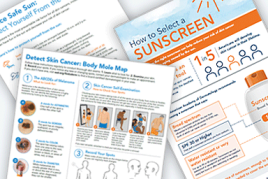11 tips to prevent nail fungus
How to prevent and treat nail fungus
Although fungal nail infections are usually painless, the condition can be unsightly. To help prevent nail fungus, board-certified dermatologists offer these tips.
Nail fungus is better prevented than treated. Treatment can take about a year and often requires prescription medication.
To help you prevent nail fungus, here are 11 tips that dermatologists give their patients:
Keep your feet clean and dry. A warm, damp area provides the perfect environment for fungi to thrive. The following can help you avoid having damp or sweaty feet for too long:
- Wear moisture-wicking socks.
- Put on a clean (not worn since washed) pair of socks every day.
- If your socks get sweaty (even moisture-wicking socks can), change them.
- Give your shoes 24 hours to dry before wearing them again.
- Wear breathable shoes, such as those made of leather, canvas, or mesh. These materials allow for airflow and help prevent your feet from sweating.
Place an antifungal powder or spray on your socks and in your shoes before you put your shoes on. This is especially important in hot weather and before a workout. While these products cannot treat nail fungus, they can prevent fungi from growing in your shoes.
Wear shoes, flip flops, or shower sandals in locker rooms, gyms, spas, shared showers, and on pool decks. Fungi thrive in these warm, moist places. If fungi are on the floor and touch your skin, you can develop nail fungus, a fungal skin infection, or both.
Never share nail-grooming tools like nail clippers, unwashed towels, shoes, and other personal items. The fungi that cause nail fungus and fungal skin infections like athlete’s foot spread easily from person to person.
Keep your nails short. This helps prevent fungi and other germs from collecting under your nails. When trimming toenails, you want to cut them straight across and keep them shorter than the end of your toes. Fingernails should also be kept short.
Disinfect your nail clippers after each use. Properly sanitizing your nail clippers and other nail-grooming tools can prevent infections like nail fungus. To give you expert advice, we asked board-certified dermatologist Amit Om, MD, FAAD, how to do this at home.

How do you sanitize your nail clippers at home?

- Remove any nail clippings or other fragments from your clippers.
- Wash the clippers with warm water and soap. Disinfectants don’t work well on dirty surfaces, so you want to wash before you disinfect.
- Disinfect the clippers, as follows:
If you have nail fungus, a wart, or other infection on your hand or foot: Use a bleach and water solution. In a clean (not used since washed) cup that you will want to use only for this purpose, add:
- 1 cup of water
- 1 tablespoon of bleach
Soak the nail clippers for 5 minutes.
If you don’t have nail fungus, a wart, or other infection on your hand or foot: Disinfect with 70% rubbing alcohol. Either wipe off or soak the nail clippers. If you soak, leave the nail clippers in the rubbing alcohol for 5 minutes.
- Remove the nail clippers and let them air-dry. Make sure they dry completely before you store them.
─ Dr. Amit Om, MD, FAAD
Before having a manicure or pedicure at a salon, look around to see if staff are sanitizing nail-grooming tools and foot baths before each use. Most salons take care to properly sanitize nail-grooming tools and foot baths for each client. Still, it’s helpful to pay attention, so you can make sure this happens. If you don’t see this, ask for it to be done before your service.
If you develop signs of athlete’s foot — cracked, scaly, or peeling skin on one or both feet or itching, burning, or stinging, especially between your toes — treat it immediately. Athlete’s foot is caused by fungi that can spread to your toenails and cause nail fungus.
When treating nail fungus, either throw away or disinfect shoes that you wore before you started treatment and wash all socks in hot water and detergent. Fungi can live in shoes, boots, and other footwear, giving you another infection. To disinfect shoes, you can use a shoe sanitizer, such as one that uses UV light.
Check your nails for signs of an infection like nail thickening, splitting, discoloration, or lifting. If you see any of these signs, make an appointment to see a board-certified dermatologist. When caught early, nail fungus may clear with treatment you apply to your infected nail(s). If you need a dermatologist, go to Find a Dermatologist.
Make sure any person you live with who has nail fungus or athlete’s foot gets treatment. It’s common for people who live in the same home to pick up the fungus that causes these conditions. If someone has nail fungus or athlete’s foot, you can develop nail fungus.
References
Gold LFS and Rosen T. “Onychomycosis: Diagnosis, treatment, and prevention strategies.” Dermatology News (A CME/CE certified supplement). March 2016:2-15.
Zaraa I, Dehavay F, et al. “Onychomycosis.” Hand Surg Rehabil. 2024 Apr;43S:101638.
Written by:
Paula Ludmann, MS
Reviewed by:
William Warren Kwan, MD, FAAD
Shari Lipner, MD, PhD, FAAD
Temitayo Ogunleye, MD, FAAD
Amit Om, MD, FAAD
Last updated: 6/26/25
 Atopic dermatitis: More FDA-approved treatments
Atopic dermatitis: More FDA-approved treatments
 Biosimilars: 14 FAQs
Biosimilars: 14 FAQs
 How to trim your nails
How to trim your nails
 Relieve uncontrollably itchy skin
Relieve uncontrollably itchy skin
 Fade dark spots
Fade dark spots
 Untreatable razor bumps or acne?
Untreatable razor bumps or acne?
 Tattoo removal
Tattoo removal
 Scar treatment
Scar treatment
 Free materials to help raise skin cancer awareness
Free materials to help raise skin cancer awareness
 Dermatologist-approved lesson plans, activities you can use
Dermatologist-approved lesson plans, activities you can use
 Find a Dermatologist
Find a Dermatologist
 What is a dermatologist?
What is a dermatologist?

